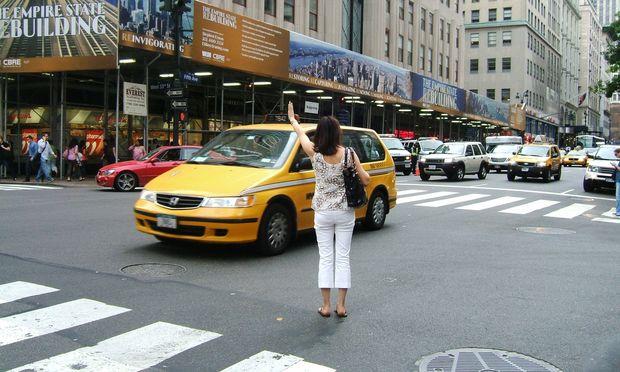Taxi-hailing apps offer unexpected benefit to minority riders
A rider hails a yellow cab in Midtown, New York City the old-fashioned way. (Photo by Flickr user bluepix52.)
Most city dwellers are familiar with vain attempts to flag down a cab when it’s raining or freezing — or both.
But new taxi-hailing smartphone apps are revolutionizing the relevancy of the outstretched arm and whistle.
Apps like Hailo, Uber and Flywheel are taking off on a national scale, particularly in cities where taxi service is relatively poor, like San Francisco and Washington, D.C.
In San Francisco, people use Flywheel to call for 16,000 rides per month from 800 of the city’s 1,500 licensed cabs. Hailo has more than 500 city cabs shuttling passengers in Chicago every day. Also in Chicago, Uber, which originated as a town car service, has just added hundreds of drivers to its roster to accommodate a newly introduced taxi option.
But in New York City, on-demand taxi apps have been slow to catch on. A recent report found that of the approximately 117,000 requests made using apps in June, the first month of the program, only 17 percent successfully concluded in a driver picking up a passenger. Trips facilitated by the apps accounted for just one quarter of one percent of all yellow taxi rides.
However, because the apps keep hailers anonymous they have a chance to level the field for minorities, many of whom find difficulty in flagging down a cab in the city.
“One of the advantages of these kinds of apps is they remove the uncertainty that you face that a cab driver will pass you by because they’re profiling you based on how you look expecting that you will maybe want to go to the outer boroughs like Brooklyn or Queens or sort of more nefariously potentially be a criminal,” said Stacy-Marie Ishmael, a product manager at a tech startup and New Yorker.
Ishmael said it is common for minorities to get passed over for travelers who look “less brown.” The discrimination takes all kinds of forms, she said.
“I had an interesting experience in that, until very recently, I had extremely long dreadlocks and I wore a head wrap and I would almost never get a cab,” Ishmael said. “And then I cut all my hair off and then I got a cab all of the time.”
E-hailing apps have been hampered in New York in part because the city barred them from facilitating automatic payment — a large chunk of the appeal for such apps.
“Unlike in other cities, a lot these apps, Hailo in particular, don’t take care of the transaction for you in terms of payment,” Ishamel said. “So when I use Hailo in London I never have to give the taxi driver cash because it just accepts my credit card details in the app, the ride is done and I’m out. It’s over.”
The apps also offer a unique safety feature. Users can share their location with friends or family to ensure safe delivery to their destination.
“If you’re getting into a cab late at night — I can actually send a text to somebody and say ‘Hey I’m in this cab and I’ll be home shortly and if I’m not home sound the alarm,” Ishamel said.
Taxi drivers have found the app useful as well, Ishmael said. One driver she talked to said he finds it useful off of peak hours, when he’s just driving around looking for fares. The app helps him connect with those looking for a ride.
